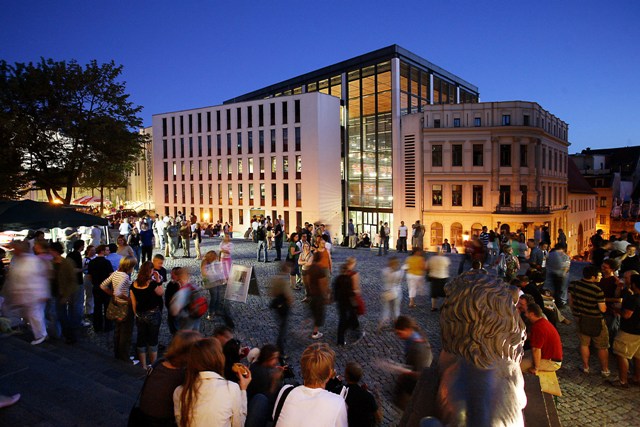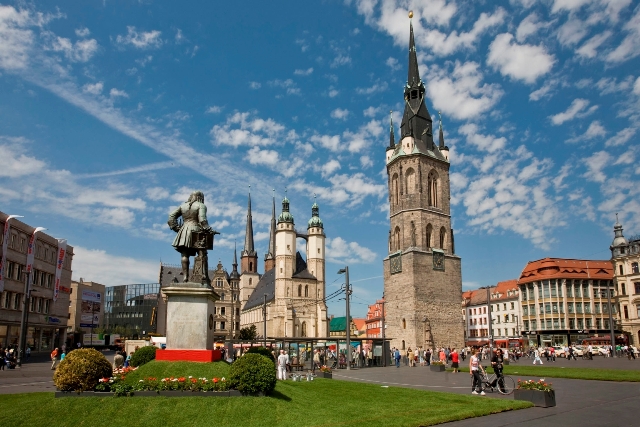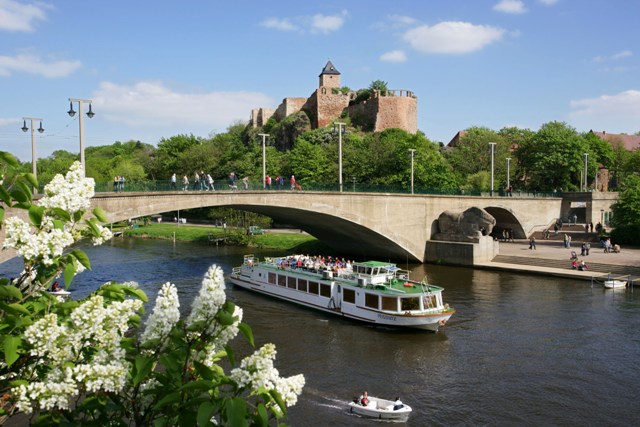Halle (Saale), an interesting and extraordinary city in Saxony-Anhalt
Halle (Saale) has an approximate population of 230,000 making it Saxony-Anhalt’s largest town in terms of residents. It lies on the banks of the river Saale and has excellent transport connections. A concentrated mix of art, culture, relaxation, restaurants and shops in a historically developed city centre makes the town popular and adorable. The city is also a green town, with its more than 7000 hectares of water and green spaces it is a leisure and sporting paradise.
There is much to listen to in Händel’s place of birth (Händel Festival, Children’s Choir Festival), to celebrate (Lantern Festival, Salt Festival), to look at Himmelsscheibe (Sky Disc), there is also Moritzburg Castle, graveyard Stadtgottesacker, Franckesche Foundation, Dome, Marien Library. To experience opera there are theatres and the music hall.
Besides this Halle (Saale) is an important business, technology and scientific location. Together with Leipzig, which is located 38 kilometres from Halle, Halle (Saale) forms the centre of the urban economic metropolitan area of central Germany. Companies, such as the Halloren Chocolate Factory Ltd. the Kathi Rainer Thiele Ltd. and the KSB Group, which are all located in the town on the banks of the Saale, are known throughout the country. Furthermore, numerous scientific institutes are located here such as the Max Planck Association or the Fraunhofer Institute. The Martin Luther University Halle Wittenberg and the Burg Giebichenstein Academy of Art and Design Halle attract many thousands of students to Halle (Saale) each year.

Apart from science, beautiful arts have also always been at home in Halle. Georg Friedrich Händel was born here and it was here that he took up his first job as a church musician. In the 20th century the artist and graphic designer Lyonel Feininger was attracted to the town, he presented the town’s structures excellently as paintings on canvas. In year 2003 they connected his activities into a tour, named “Feiniger Round Tour”. Today the Burg Giebichenstein Art Academy is one of Germany’s leading places of education for graphic designers, sculptors.
The history of the old salt town is visible everywhere. You can discover many interesting things around and within the old houses. For example, there is now a museum in Händel’s birth house, and, in the market-church one is able to gaze in amazement at Martin Luthers death mask. However, the town is able to offer much more.
Halle is also sweet
Halloren Schokoladenfabrik is the oldest chocolate factory in Germany. Its origins date back to the founding in 1804 in Halle (Saale) where it still has its headquarter. Today Halloren is one of the most successful traditionally chocolate factories in Europe with an extensive range of finest chocolates and sweets.
Most famous products are the "Original Halloren Kugeln". Many different flavours are available and the range is constantly expanding.
Furthermore the product range contains exclusive chocolates, chocolate mini bars and solid shaped chocolates, liqueur-filled selections such as brandy beans and cherries, delicious almond paste specialties, finest Belgian chocolate, tasty pralines and wafers, customized chocolate coins and medallions, chocolate covered candies as well as sugared jellies.
The new Youth Hostel - An additional attraction in the centre of the city
On 29th of June in 2015 the new house was open the doors to greet the guests of Halle. They renovated an old school from 1871 and made it into a modern
Youth Hostel with 229 beds in 75 rooms. All rooms have a shower and a toilet. Eight of these rooms are suitable for disabled persons. In addition to the two-, three- and four-bed rooms you will find seminar rooms, space for extracurricular activity and a cafeteria.
You are always welcome, especially if you want discover and experience an extraordinary city in Saxony-Anhalt.


